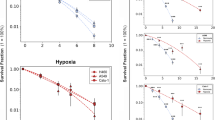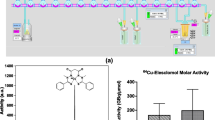Abstract
Purpose
Hypoxia occurs frequently in cancers and can lead to therapeutic resistance due to poor perfusion and loss of the oxygen enhancement effect. 64Cu-ATSM has shown promise as a hypoxia diagnostic agent due to its selective uptake and retention in hypoxic cells and its emission of positrons for PET imaging. 64Cu also emits radiotoxic Auger electrons and β- particles and may therefore exhibit therapeutic potential when concentrated in hypoxic tissue.
Methods
MCF-7 cells were treated with 0–10 MBq/ml 64Cu-ATSM under differing oxygen conditions ranging from normoxia to severe hypoxia. Intracellular response to hypoxia was measured using Western blotting for expression of HIF-1α, while cellular accumulation of 64Cu was measured by gamma counting. DNA damage and cytotoxicity were measured with, respectively, the Comet assay and clonogenic survival.
Results
64Cu-ATSM uptake in MCF-7 cells increased as atmospheric oxygen decreased (up to 5.6 Bq/cell at 20.9% oxygen, 10.4 Bq/cell at 0.1% oxygen and 26.0 Bq/cell at anoxia). Toxicity of 64Cu-ATSM in MCF-7 cells also increased as atmospheric oxygen decreased, with survival of 9.8, 1.5 and 0% in cells exposed to 10 MBq/ml at 20.9, 0.1 and 0% oxygen. The Comet assay revealed a statistically significant increase in 64Cu-ATSM-induced DNA damage under hypoxic conditions.
Conclusion
The results support a model in which hypoxia-enhanced uptake of radiotoxic 64Cu induces sufficient DNA damage and toxicity to overcome the documented radioresistance in hypoxic MCF-7 cells. This suggests that 64Cu-ATSM and related complexes have potential for targeted radionuclide therapy of hypoxic tumours.






Similar content being viewed by others
Abbreviations
- PET:
-
Positron emission tomography
- LET:
-
Linear energy transfer
- 64Cu-ATSM:
-
64Cu-diacetyl-bis(N(4)-methylthiosemicarbazone)
- HIF-1α:
-
Hypoxia-inducible factor 1α
- DMEM:
-
Dulbecco’s modified Eagle’s medium
- HBSS:
-
Hanks’ balanced salt solution
References
Krohn KA, Link JM, Mason RP. Molecular imaging of hypoxia. J Nucl Med 2008;49(Suppl 2):129S–48S.
Dearling JL, Lewis JS, Mullen GE, Rae MT, Zweit J, Blower PJ. Design of hypoxia-targeting radiopharmaceuticals: selective uptake of copper-64 complexes in hypoxic cells in vitro. Eur J Nucl Med 1998;25:788–92.
Lewis JS, McCarthy DW, McCarthy TJ, Fujibayashi Y, Welch MJ. Evaluation of 64Cu-ATSM in vitro and in vivo in a hypoxic tumor model. J Nucl Med 1999;40:177–83.
Dearling JL, Lewis JS, Mullen GE, Welch MJ, Blower PJ. Copper bis(thiosemicarbazone) complexes as hypoxia imaging agents: structure-activity relationships. J Biol Inorg Chem 2002;7:249–59.
McQuade P, Martin KE, Castle TC, Went MJ, Blower PJ, Welch MJ, et al. Investigation into 64Cu-labeled Bis(selenosemicarbazone) and Bis(thiosemicarbazone) complexes as hypoxia imaging agents. Nucl Med Biol 2005;32:147–56.
Bonnitcha PD, Vāvere AL, Lewis JS, Dilworth JR. In vitro and in vivo evaluation of bifunctional bisthiosemicarbazone 64Cu-complexes for the positron emission tomography imaging of hypoxia. J Med Chem 2008;51:2985–91.
Maurer RI, Blower PJ, Dilworth JR, Reynolds CA, Zheng Y, Mullen GE. Studies on the mechanism of hypoxic selectivity in copper bis(thiosemicarbazone) radiopharmaceuticals. J Med Chem 2002;45:1420–31.
Burgman P, O’Donoghue JA, Lewis JS, Welch MJ, Humm JL, Ling CC. Cell line-dependent differences in uptake and retention of the hypoxia-selective nuclear imaging agent Cu-ATSM. Nucl Med Biol 2005;32:623–30.
Lewis JS, Sharp TL, Laforest R, Fujibayashi Y, Welch MJ. Tumor uptake of copper-diacetyl-bis(N(4)-methylthiosemicarbazone): effect of changes in tissue oxygenation. J Nucl Med 2001;42:655–61.
Lewis JS, Herrero P, Sharp TL, Engelbach JA, Fujibayashi Y, Laforest R, et al. Delineation of hypoxia in canine myocardium using PET and copper(II)-diacetyl-bis(N(4)-methylthiosemicarbazone). J Nucl Med 2002;43:1557–69.
Obata A, Yoshimoto M, Kasamatsu S, Naiki H, Takamatsu S, Kashikura K, et al. Intra-tumoral distribution of (64)Cu-ATSM: a comparison study with FDG. Nucl Med Biol 2003;30:529–34.
Tanaka T, Furukawa T, Fujieda S, Kasamatsu S, Yonekura Y, Fujibayashi Y. Double-tracer autoradiography with Cu-ATSM/FDG and immunohistochemical interpretation in four different mouse implanted tumor models. Nucl Med Biol 2006;33:743–50.
O’Donoghue JA, Zanzonico P, Pugachev A, Wen B, Smith-Jones P, Cai S, et al. Assessment of regional tumor hypoxia using 18F-fluoromisonidazole and 64Cu(II)-diacetyl-bis(N4-methylthiosemicarbazone) positron emission tomography: comparative study featuring microPET imaging, Po2 probe measurement, autoradiography, and fluorescent microscopy in the R3327-AT and FaDu rat tumor models. Int J Radiat Oncol Biol Phys 2005;61:1493–502.
Yuan H, Schroeder T, Bowsher JE, Hedlund LW, Wong T, Dewhirst MW. Intertumoral differences in hypoxia selectivity of the PET imaging agent 64Cu(II)-diacetyl-bis(N4-methylthiosemicarbazone). J Nucl Med 2006;47:989–98.
Dehdashti F, Mintun MA, Lewis JS, Bradley J, Govindan R, Laforest R, et al. In vivo assessment of tumor hypoxia in lung cancer with 60Cu-ATSM. Eur J Nucl Med Mol Imaging 2003;30:844–50.
Dehdashti F, Grigsby PW, Lewis JS, Laforest R, Siegel BA, Welch MJ. Assessing tumor hypoxia in cervical cancer by PET with 60Cu-labeled diacetyl-bis(N4-methylthiosemicarbazone). J Nucl Med 2008;49:201–5.
Dehdashti F, Grigsby PW, Mintun MA, Lewis JS, Siegel BA, Welch MJ. Assessing tumor hypoxia in cervical cancer by positron emission tomography with 60Cu-ATSM: relationship to therapeutic response-a preliminary report. Int J Radiat Oncol Biol Phys 2003;55:1233–8.
Grigsby PW, Malyapa RS, Higashikubo R, Schwarz JK, Welch MJ, Huettner PC, et al. Comparison of molecular markers of hypoxia and imaging with (60)Cu-ATSM in cancer of the uterine cervix. Mol Imaging Biol 2007;9:278–83.
Lewis J, Laforest R, Buettner T, Song S, Fujibayashi Y, Connett J, et al. Copper-64-diacetyl-bis(N4-methylthiosemicarbazone): an agent for radiotherapy. Proc Natl Acad Sci U S A 2001;98:1206–11.
Laforest R, Dehdashti F, Lewis JS, Schwarz SW. Dosimetry of 60/61/62/64Cu-ATSM: a hypoxia imaging agent for PET. Eur J Nucl Med Mol Imaging 2005;32:764–70.
McCarthy DW, Shefer RE, Klinkowstein RE, Bass LA, Margeneau WH, Cutler CS, et al. Efficient production of high specific activity 64Cu using a biomedical cyclotron. Nucl Med Biol 1997;24:35–43.
Hartmann A, Agurell E, Beevers C, Brendler-Schwaab S, Burlinson B, Clay P, et al. Recommendations for conducting the in vivo alkaline Comet assay. 4th International Comet Assay Workshop. Mutagenesis 2003;18:45–51.
Olive PL, Banáth JP, Durand RE. Heterogeneity in radiation-induced DNA damage and repair in tumor and normal cells measured using the “comet” assay. Radiat Res 1990;122:86–94.
Kallio PJ, Okamoto K, O’Brien S, Carrero P, Makino Y, Tanaka H, et al. Signal transduction in hypoxic cells: inducible nuclear translocation and recruitment of the CBP/p300 coactivator by the hypoxia-inducible factor-1alpha. EMBO J 1998;17:6573–86.
Obata A, Kasamatsu S, Lewis JS, Furukawa T, Takamatsu S, Toyohara J, et al. Basic characterization of 64Cu-ATSM as a radiotherapy agent. Nucl Med Biol 2005;32:21–8.
Höckel M, Vaupel P. Tumor hypoxia: definitions and current clinical, biologic, and molecular aspects. J Natl Cancer Inst 2001;93:266–76.
Marshall RS, Koch CJ, Rauth AM. Measurement of low levels of oxygen and their effect on respiration in cell suspensions maintained in an open system. Radiat Res 1986;108:91–101.
Anoopkumar-Dukie S, Conere T, Carey JB, Allshire A. Radical mediators and mitogen-activated protein kinase signaling in oxygen-dependent radiosensitivity of human tumor cell lines. Free Radic Biol Med 2005;39:188–94.
Bindra RS, Crosby ME, Glazer PM. Regulation of DNA repair in hypoxic cancer cells. Cancer Metastasis Rev 2007;26:249–60.
An WG, Kanekal M, Simon MC, Maltepe E, Blagosklonny MV, Neckers LM. Stabilization of wild-type p53 by hypoxia-inducible factor 1alpha. Nature 1998;392:405–8.
Hammond EM, Giaccia AJ. The role of p53 in hypoxia-induced apoptosis. Biochem Biophys Res Commun 2005;331:718–25.
Qaim SM, Bisinger T, Hilgers K, Nayak D, Coenen HH. Positron emission intensities in the decay of 64Cu, 76Br and 124I. Radiochim Acta 2007;95:67–73.
Goddu SM, Howell RW, Rao DV. Cellular dosimetry: absorbed fractions for monoenergetic electron and alpha particle sources and S-values for radionuclides uniformly distributed in different cell compartments. J Nucl Med 1994;35:303–16.
Faraggi M, Gardin I, de Labriolle-Vaylet C, Moretti JL, Bok BD. The influence of tracer localization on the electron dose rate delivered to the cell nucleus. J Nucl Med 1994;35:113–9.
Faraggi M, Gardin I, Stievenart JL, Bok BD, Le Guludec D. Comparison of cellular and conventional dosimetry in assessing self-dose and cross-dose delivered to the cell nucleus by electron emissions of 99mTc, 123I, 111In, 67Ga and 201T1. Eur J Nucl Med 1998;25:205–14.
Acknowledgements
This work was supported by a grant (S60389) from the Engineering and Physical Sciences Research Council to PJB, DRL and PKM. The technical support and assistance of Philip Halsted in the preparation of 64Cu is gratefully acknowledged.
Conflicts of interest
None.
Author information
Authors and Affiliations
Corresponding author
Additional information
This manuscript does not describe work involving human participants.
Rights and permissions
About this article
Cite this article
Weeks, A.J., Paul, R.L., Marsden, P.K. et al. Radiobiological effects of hypoxia-dependent uptake of 64Cu-ATSM: enhanced DNA damage and cytotoxicity in hypoxic cells. Eur J Nucl Med Mol Imaging 37, 330–338 (2010). https://doi.org/10.1007/s00259-009-1305-8
Received:
Accepted:
Published:
Issue Date:
DOI: https://doi.org/10.1007/s00259-009-1305-8




